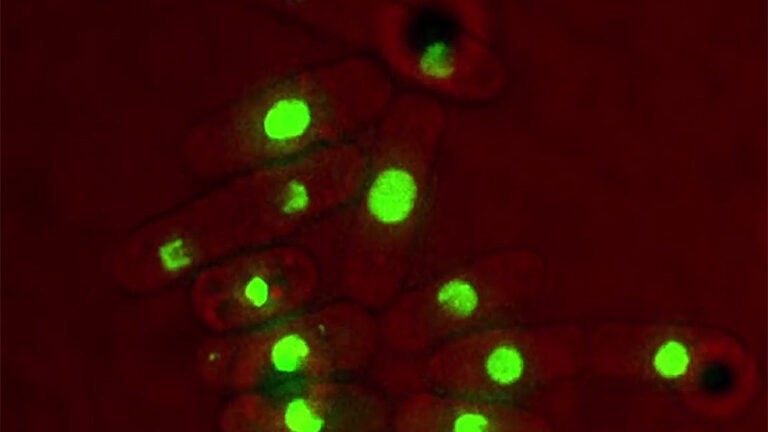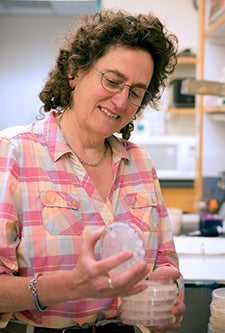
Biologist studies instability in yeast DNA to understand cancer in humans
As dissimilar as they are, certain yeast and human cells have much in common when it comes to how they deal with instability in their genomes. Studying the simpler yeast, Susan Forsburg hopes to shed light on these essential, shared processes — revealing information that one day could lead to cures for cancer and other genetic disorders.
“At a fundamental level, we’re interested in how cells try to maintain the integrity of their genome, specifically in response to challenges during the process of DNA replication, which is a very vulnerable time,” said Forsburg, professor of biological sciences.
For cells to multiply, they must unwrap the tightly wound chromosomes, unzip the slender double helix of DNA, and faithfully copy it, before putting it all back together again. The process is rife with opportunities for the DNA to suffer damage.
Three paths to answers
Forsburg’s research aims to understand how cells manage stresses during DNA replication to minimize damage, focusing on three main areas of inquiry.
The first seeks to determine how cells respond to replication stress throughout the whole cell, and particularly what happens to those that survive.

Susan Forsburg, professor of biological sciences at USC Dornsife. Photo by Peter Zhaoyu Zhou.
The second looks at meiosis, the specialized process leading to the production of reproductive cells — spores in yeast, and eggs and sperm in humans.
“Humans are spectacularly bad at reproducing; up to 50 percent of pregnancies end in miscarriage, and more than half of that probably because of defects in meiosis,” Forsburg said. “So we’re interested in how these principles that we’re learning in the process of normal cell division apply to this very specialized differentiation process.”
The third area of research aims to uncover regions of the genome that are particularly vulnerable fragile sites and understand how protections may differ for them compared to the rest of the genome.
The work recently gained support from the National Institute of General Medical Sciences (NIGMS), a part of the National Institutes of Health, through a new grant program. Dubbed MIRA (short for Maximizing Investigators’ Research Award), the grants provide investigators with greater stability and flexibility to improve the chances for important breakthroughs, according to the NIGMS website.
Forsburg was among the first group of investigators in the nation to receive MIRA awards.
Mower first, Mercedes later
To understand factors affecting genomic stability, Forsburg studies the yeast Schizosaccharomyces pombe, a single-cell organism that is well-established as a model for studying chromosomes. Yeast hold several advantages over human cells when it comes to this kind of research: They’re less expensive, they grow more quickly and they’re much easier to manipulate. Importantly, yeast cells use the same genes as humans to maintain their genomes.
Forsburg compares the use of yeast versus human tissue culture cells to studying lawn mower engines before working on a Mercedes.
Professor of molecular biology Susan Forsburg studies how chromosome duplication and
maintenance contributes to overall genome stability in a model genetic system. Loss of genome integrity
and deregulation of cell division is associated with cancer, so this is a fundamental form of cancer research.
“I look for the simplest system that does the thing I’m interested in,” she said. “The model I use when I’m discussing this with students is, if you’re from Mars and you don’t know how an internal combustion engine works, you could try to figure it out with a Mercedes, but that’s going to be hard. But if you were trained as a biologist on Mars, you would say that a gas lawn mower in the corner of the garage clearly is working on the same principle.”
Understanding the simpler, more basic mower would give the Martian a head start in understanding the more complex Mercedes, just as working on yeast paves the way to understanding human cells.
This type of clarity in explaining fundamental issues in science to students, among other teaching expertise, earned Forsburg the 2016 USC Associates Award for Excellence in Teaching. She received the recognition during the university’s 35th annual Academic Honors Convocation in April.
Light in the tunnel
Forsburg sees her exploration of yeast genomic stability as a crucial first step on the path to disease-fighting treatments.
“I describe basic biologists as the guys exploring in the caves with torches trying to determine if a tunnel goes somewhere,” she said. Later researchers might then string electric lighting and look more carefully to see if the tunnel holds something useful, but you need those initial discovery scientists first.
“You need somebody to find the tunnel before you can determine if there’s something worth exploring in there — someone who can say, ‘I wonder if there’s anything down this way?’ And that pure discovery aspect of science is the most exciting place to be.”